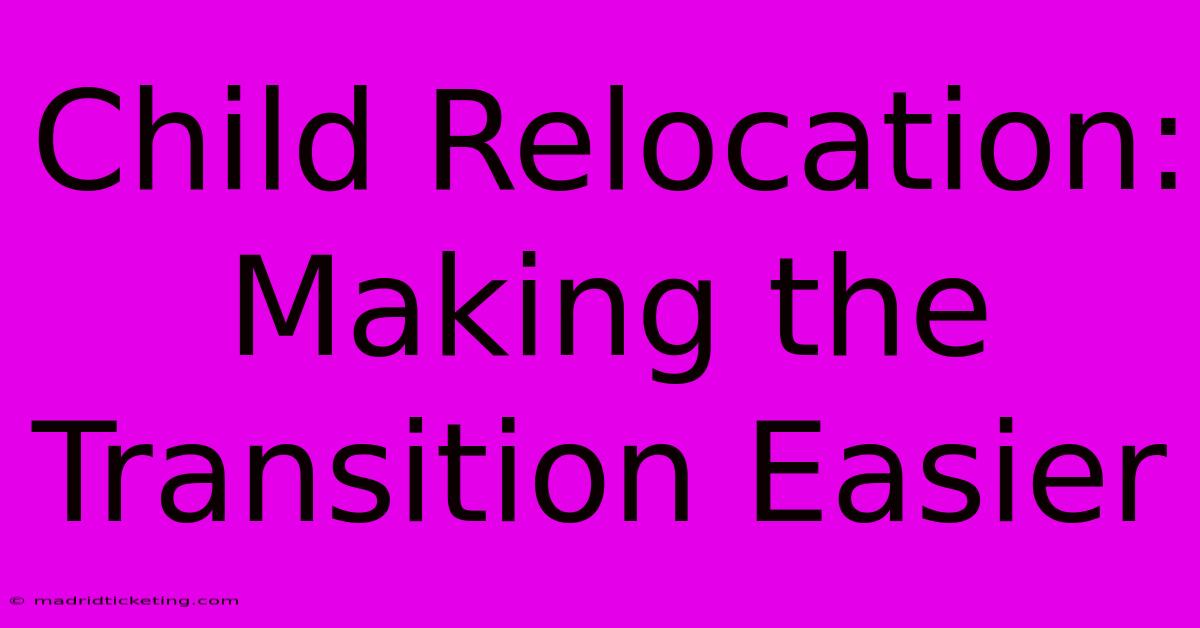Child Relocation: Making The Transition Easier

Table of Contents
Child Relocation: Making the Transition Easier
Relocating with children is a significant undertaking, filled with both excitement and anxiety. Successfully navigating this transition requires careful planning and a sensitive approach to minimize disruption and maximize your child's well-being. This comprehensive guide offers practical strategies and valuable insights to make the move smoother for your family.
Preparing Your Child for the Move
Open Communication is Key: Begin talking to your child about the relocation well in advance. Use age-appropriate language to explain the reasons for the move and what they can expect. Answer their questions honestly and address any concerns they may have. Avoid surprises; the more involved they feel in the process, the easier the transition will be.
Involve Your Child in the Planning Process:
- Let them choose: Allow them to select some items to pack, participate in choosing a new house (if applicable), or help decorate their new room. This gives them a sense of control and ownership.
- Create a scrapbook or photo album: Document your current home and neighborhood. This creates a lasting memory and helps your child maintain a connection to their familiar surroundings.
- Research the new location: Show your child pictures and videos of their new school, park, or neighborhood. Highlight the positive aspects and exciting opportunities.
- Visit the new location before moving: If possible, take a trip to your new home before the big move. This allows your child to explore their surroundings and adjust gradually.
Managing the Practicalities of Relocation
School Transitions: Arrange for enrollment in the new school well in advance. If possible, schedule a visit to meet the principal, teachers, and even tour the school with your child. This helps reduce anxiety about a new learning environment.
Maintaining Continuity:
- Maintain familiar routines: Stick to established bedtimes, mealtimes, and other familiar routines as much as possible during the transition. This provides a sense of normalcy and security.
- Pack essentials separately: Keep a box of your child's favorite toys, books, and comfort items easily accessible during the move. This will help them feel comforted and secure in their new environment.
- Stay organized: Create a detailed moving checklist and keep track of all important documents, such as school records and medical information.
Addressing Emotional Challenges
Relocation can trigger a range of emotions in children, from excitement to sadness and anxiety. Be patient and understanding, allowing your child to express their feelings freely.
Strategies for Emotional Support:
- Acknowledge their feelings: Validate your child's emotions, even if they seem irrational. Let them know it's okay to feel sad, angry, or scared.
- Spend quality time together: Make time for special activities that your child enjoys, providing consistent love and support.
- Maintain social connections: Help your child maintain contact with friends and family from their previous location through video calls, emails, or letters.
- Seek professional help: If your child is experiencing significant emotional distress, don't hesitate to seek professional help from a therapist or counselor specializing in child relocation.
Making the New Home Feel Welcoming
Once you've settled into your new home, focus on creating a welcoming and comfortable environment for your child.
Creating a Sense of Belonging:
- Personalize their space: Encourage your child to decorate their new room and make it feel like their own.
- Explore the neighborhood: Spend time exploring parks, playgrounds, and other local attractions. This helps your child become familiar with and comfortable in their new surroundings.
- Join community groups: Find ways to connect with other families and children in your new community. This helps build a support network and friendships.
Relocating with children is challenging, but with careful planning, open communication, and a supportive environment, you can make the transition a positive experience for your entire family. Remember that patience and understanding are key throughout the process. By focusing on your child's emotional well-being and proactively addressing their concerns, you can help them adapt to their new home and thrive in their new surroundings.

Thank you for visiting our website wich cover about Child Relocation: Making The Transition Easier. We hope the information provided has been useful to you. Feel free to contact us if you have any questions or need further assistance. See you next time and dont miss to bookmark.
Featured Posts
-
Choosing The Right Madrid Barrio For Your Trip
Apr 02, 2025
-
Need A Lawyer Now Madrids 24 7 Service
Apr 02, 2025
-
Explore Andalucia By High Speed Train Madrid To Cordoba
Apr 02, 2025
-
Unlock Your Inner Fan 17 18 Real Madrid Away Jersey
Apr 02, 2025
-
Retro Vibes The Iconic 17 18 Real Madrid Jersey
Apr 02, 2025
